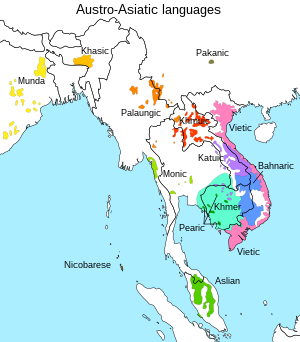| Austroasiatic | |
|---|---|
| Austro-Asiatic | |
| Geographic distribution | Southeast, South and East Asia |
| Linguistic classification | One of the world's primary language families |
| Proto-language | Proto-Austroasiatic |
| Subdivisions | |
| Language codes | |
| ISO 639-5 | aav |
| Glottolog | aust1305 (Austroasiatic) |
 | |
The Austroasiatic languages[note 1] (/ˌɒstroʊ.eɪʒiˈætɪk, ˌɔː-/ OSS-troh-ay-zhee-AT-ik, AWSS-) are a large language family spoken throughout Mainland Southeast Asia, South Asia and East Asia. These languages are natively spoken by the majority of the population in Vietnam and Cambodia, and by minority populations scattered throughout parts of Thailand, Laos, India, Myanmar, Malaysia, Bangladesh, Nepal, and southern China. Approximately 117 million people speak an Austroasiatic language, of which more than two-thirds are Vietnamese speakers.[1] Of the Austroasiatic languages, only Vietnamese, Khmer, and Mon have lengthy, established presences in the historical record. Only two are presently considered to be the national languages of sovereign states: Vietnamese in Vietnam, and Khmer in Cambodia. The Mon language is a recognized indigenous language in Myanmar and Thailand, while the Wa language is a "recognized national language" in the de facto autonomous Wa State within Myanmar. Santali is one of the 22 scheduled languages of India. The remainder of the family's languages are spoken by minority groups and have no official status.
Ethnologue identifies 168 Austroasiatic languages. These form thirteen established families (plus perhaps Shompen, which is poorly attested, as a fourteenth), which have traditionally been grouped into two, as Mon–Khmer,[2] and Munda. However, one recent classification posits three groups (Munda, Mon-Khmer, and Khasi–Khmuic),[3] while another has abandoned Mon–Khmer as a taxon altogether, making it synonymous with the larger family.[4]
Scholars generally date the ancestral language to c. 3000 BCE – c. 2000 BCE with a homeland in southern China or the Mekong River valley. Sidwell (2022) proposes that the locus of Proto-Austroasiatic was in the Red River Delta area around c. 2500 BCE – c. 2000 BCE.[5] Genetic and linguistic research in 2015 about ancient people in East Asia suggest an origin and homeland of Austroasiatic in today southern China or even further north.[6]
Cite error: There are <ref group=note> tags on this page, but the references will not show without a {{reflist|group=note}} template (see the help page).
- ^ "Austroasiatic". www.languagesgulper.com. Archived from the original on 29 March 2019. Retrieved 15 October 2017.
- ^ Bradley (2012) notes, MK in the wider sense including the Munda languages of eastern South Asia is also known as Austroasiatic.
- ^ Diffloth 2005
- ^ Sidwell 2009
- ^ Cite error: The named reference
Sidwell JSEALS Special 8was invoked but never defined (see the help page). - ^ Zhang, Xiaoming; Liao, Shiyu; Qi, Xuebin; Liu, Jiewei; Kampuansai, Jatupol; Zhang, Hui; Yang, Zhaohui; Serey, Bun; Tuot, Sovannary (20 October 2015). Y-chromosome diversity suggests southern origin and Paleolithic backwave migration of Austro- Asiatic speakers from eastern Asia to the Indian subcontinent OPEN. Vol. 5.